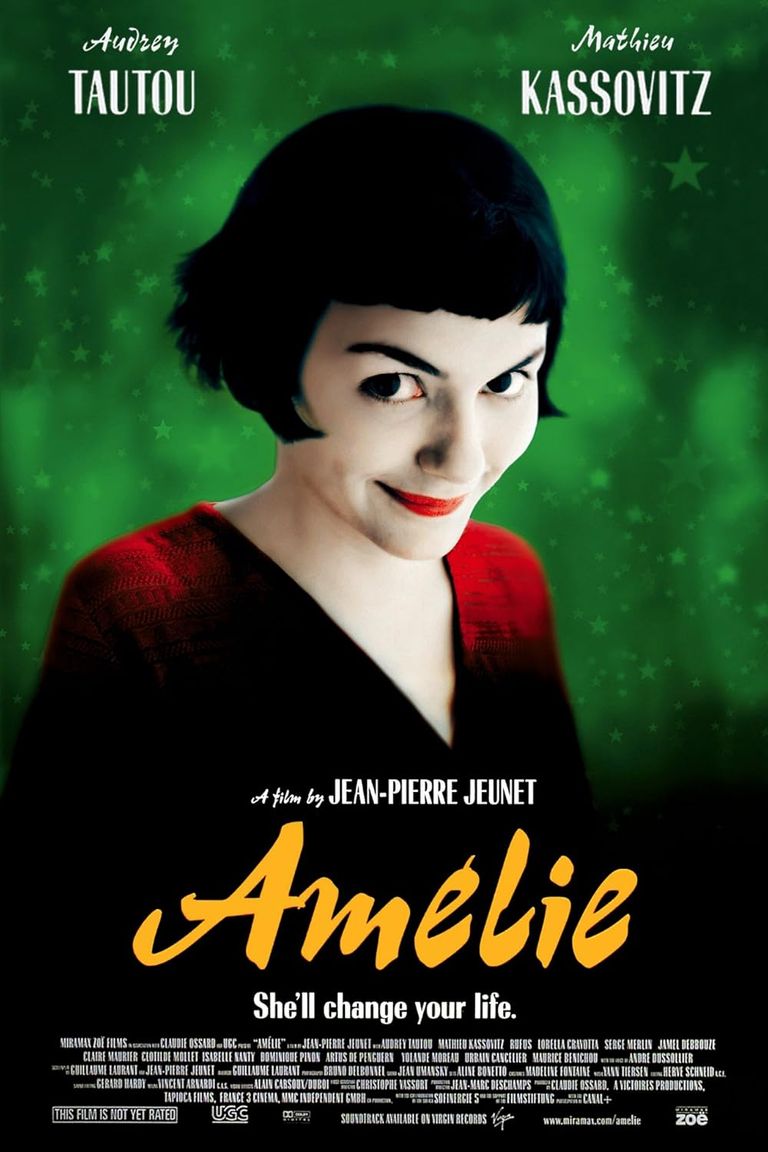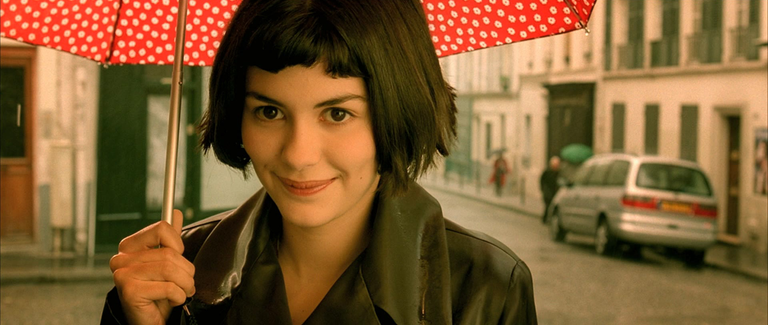
Amélie (Le Fabuleux Destin d'Amélie Poulain in its original version) is a film written and directed by Jean-Pierre Jeunet and starring Audrey Tautou and Mathieu Kassovitz .
The film was released in French cinemas on June 25, 2001 and arrived in Italian cinemas on January 25 of the following year.

Amélie (Le Fabuleux Destin d'Amélie Poulain en su versión original ) es una película escrita y dirigida por Jean-Pierre Jeunet y protagonizada por Audrey Tautou y Mathieu Kassovitz .
La película se estrenó en los cines franceses el 25 de junio de 2001 y llegó a los cines italianos el 25 de enero del año siguiente.

Amélie grows up in the provinces, in France . Her father is an overly original doctor: he visits his daughter every month, who gets agitated every time, and believes she has a heart condition. Her mother, leaving the church, is crushed by a suicide bomber. When she grows up, the girl goes to Paris. She works as a waitress and meets lots of people.
August 31, 1997 is the decisive day of her life: she sees the TV report on Lady Diana's death, a bottle cap falls out of her hand and ends up under a tile, where Amélie finds an old box of junk (stickers, a photo of a footballer, an iron cyclist). She sets out to track down the owner, who at that point will be about fifty years old. She finds him, gives him back the "memory" and changes his life.
From that moment on, she decides to make others happy, and here is a gallery of characters in the tradition of French cinema... of art: a fish who continually tries to commit suicide, a retired train employee who obliterates the leaves of his wife's plants, a painter who falsifies a painting by Renoir once a year, a blind man whom Amélie accompanies, describing to him what she sees. The film was a "case".
In the US it beat the box office of our Life is Beautiful . In France the uproar was very loud, with references to the great cinema of the past, from Carné to Malle ( Zazie in the Metro ), to Lelouch to the magical writing of Prévert.
With all due respect, Jeunet-Laurent 's screenplay , sparkling and imaginative, certainly does not come close to Prévert's depth. So Amélie , rather than being beatified, should be considered a beautiful story, different and curious, that makes you feel good, released at the right time.

Amélie crece en provincia, estamos en Francia . Su padre es un médico demasiado original: visita a su hija cada mes, y ella cada vez se pone nerviosa y cree que tiene un problema cardíaco. La madre, al salir de la iglesia, es aplastada por un terrorista suicida. Cuanto mayor es la niña, más se va a París. Ella trabaja como camarera y conoce a mucha gente.
El 31 de agosto de 1997 es el día decisivo de su vida: ve en la televisión el reportaje sobre la muerte de Lady Diana, un tapón de botella cae de su mano y acaba debajo de una baldosa, donde Amélie encuentra una vieja caja llena de trastos (pegatinas, una foto de un futbolista, un ciclista de hierro). Se propone localizar al propietario, que en ese momento tendrá unos cincuenta años. Ella lo encuentra, le devuelve la “memoria” y cambia su vida.
A partir de ese momento, decide hacer felices a los demás, y he aquí una galería de personajes en la tradición del cine francés... del arte: un pez que intenta continuamente suicidarse, un empleado de tren jubilado que borra las hojas de las plantas de su mujer, un pintor que falsifica un cuadro de Renoir una vez al año, un ciego al que Amélie acompaña describiéndole lo que ve. La película fue un "caso".
En Estados Unidos superó en taquilla a nuestra película La vida es bella . En Francia, el revuelo fue muy fuerte, con referencias al gran cine del pasado, desde Carné a Malle ( Zazie en el Metro ), pasando por Lelouch hasta la escritura mágica de Prévert.
Con el debido respeto, el guión de Jeunet-Laurent , brillante e imaginativo, ciertamente no se acerca a la profundidad de Prévert. Así que Amélie, más que beatificada, debe ser considerada una historia hermosa, diferente y curiosa, que te hace sentir bien, liberada en el momento adecuado.

In Paris, the young Amélie works as a waitress in a bar in Montmartre, the "Café des 2 Moulins", and her life passes peacefully between visits to her elderly widowed father and some pleasant pastimes (breaking the crust of the Crème brûlée with a teaspoon, bouncing stones on the Canal Saint-Martin, dipping her fingers in vegetables, etc.) that fill her daily life.
The day Princess Diana dies, she accidentally finds a small box behind a tile on a wall in her apartment. She is astonished to open it and finds small mementos and toys inside, and she realizes that it is most likely a small box hidden decades earlier by a child who lived in the same apartment.
Amélie tries to get information from the concierge to find out who the box belonged to, and after a long search she manages to get the name she needs: Dominique Bredoteau. Amélie tracks down all the inhabitants of Paris with this name, but she cannot find the old owner of the box; when she decides to give up, "the glass man" comes to her rescue.
"The Glass Man" is Amélie's neighbor, a painter by profession, and owes this nickname to a congenital disease: his bones tend to shatter abnormally easily (osteogenesis imperfecta); for this reason he almost never leaves the house and in his home everything is padded to avoid bumping into it. "The Glass Man" directs Amélie to the right person, suggesting that the surname she is looking for is Bretodeau instead of Bredoteau.
Amélie manages, with a ruse, to return the box to its original owner without being discovered. The man rediscovers moments of his childhood, now long forgotten. Casually entering the same bar frequented by Amélie, he tells her what happened to him, unaware that she is the architect of it, adding that he would like to try to mend relationships with his daughter (whom he hasn't spoken to in years) and the grandson he has never seen.
Amélie is so struck by Bretodeau's reaction that she decides, after a sleepless night, to devote her time to "fixing things" that are wrong in the lives of those close to her. With the help of a stewardess friend, she makes her father, who has been increasingly withdrawn since his wife's death, believe that his beloved garden gnome is traveling the world on vacation; she sends a letter to the concierge, who lost her husband after a romantic getaway with his lover - a collage created using pieces of original letters - that seems to have been lost in the past, thus giving her the illusion that, before dying, her husband had desperately tried to get in touch with her; she organizes some serious pranks on a cruel greengrocer who torments his boy, making him believe he has gone mad; she manages to make one of her colleagues, resigned to a single life, fall in love with a jealous and obsessive frequenter of the bar; He spreads the phrases of his friend Hipolito, a failed writer and customer of the "Café des 2 Moulins", throughout the city, reciting his verses to the train conductor or writing them on the walls.
In the meantime, she meets the gaze of Nino, a boy who as a hobby collects poorly made passport photos that have been thrown away, and Amélie falls in love with him. The second time Amélie sees the young man collecting the photos, he suddenly takes off in pursuit of a man, losing a bag with the album with the passport photos collection from his scooter. While trying to return it to her beloved Nino, Amélie is busy solving "the mystery of the passport photos", namely the image of a man who, systematically and with the same empty expression, takes passport photos of himself in train stations, and then throws them away.
She is the person chased by Nino when he loses his album: she turns out to be just a camera maintenance man, who took test photos. Due to some misunderstandings, Amélie, jealous, no longer wants to be approached by Nino; it will be a videotape message from the "Man of Glass" that will make her take the most important decision of her life: to do good to herself too, therefore to join Nino to whom she is fatally attracted (also because of the affinities that have made the complicated childhoods of the two young dreamers in a certain sense "parallel", as explained by the off-screen narrator, a sort of faceless protagonist of this cinematic work). In the end she will be able to be happy: she has helped her loved ones and has found love.

En París, la joven Amélie trabaja como camarera en un bar de Montmartre, el "Café des 2 Moulins", y su vida transcurre apaciblemente entre las visitas a su anciano padre viudo y algunos pasatiempos agradables (romper la corteza de la Crème brûlée con una cucharilla, hacer rebotar piedras en el Canal Saint-Martin, mojar los dedos en verduras, etc.) que llenan su vida cotidiana.
El día que murió la princesa Diana, accidentalmente encontró una pequeña caja detrás de un azulejo en la pared de su apartamento. Para su gran sorpresa, lo abre y encuentra pequeños recuerdos y juguetes dentro, y se da cuenta de que lo más probable es que se trate de una pequeña caja escondida décadas antes por un niño que vivía en el mismo apartamento.
Amélie intenta obtener información del conserje para saber a quién pertenecía la caja, y tras una larga búsqueda consigue conseguir el nombre que necesita: Dominique Bredoteau. Amélie busca a todos los habitantes de París con este nombre, pero no logra encontrar al antiguo propietario de la caja; Cuando decide rendirse, "el hombre de cristal" llega a su rescate.
"El Hombre de Cristal" es vecino de Amélie, pintor de profesión, y debe este apodo a una enfermedad congénita: sus huesos tienden a romperse con anormal facilidad (osteogénesis imperfecta); por eso casi nunca sale de casa y en su hogar todo está acolchado para evitar chocarse con él. "El hombre de cristal" dirige a Amélie hacia la persona adecuada, sugiriendo que el apellido que está buscando es Bretodeau en lugar de Bredoteau.
Amélie consigue, con un truco, devolver la caja a su dueño original sin ser descubierta. El hombre encuentra momentos de su infancia, ahora olvidados hace mucho tiempo. Entrando por casualidad en el mismo bar que frecuenta Amélie, le cuenta lo que le ha sucedido, sin saber que ella es la artífice de todo, y añade que le gustaría intentar arreglar las relaciones con su hija (con la que no habla desde hace años) y con su nieto, al que nunca ha visto.
Amélie queda tan impresionada por la reacción de Bretodeau que decide, después de una noche de insomnio, dedicar su tiempo a "arreglar las cosas" que están mal en la vida de sus allegados. Con la ayuda de una amiga azafata, le hace creer a su padre, cada vez más retraído desde la muerte de su esposa, que su amado gnomo de jardín está viajando alrededor del mundo de vacaciones; A la portera, que perdió a su marido tras una escapada romántica con su amante, le envía una carta -un collage creado a partir de trozos de cartas originales- que parece haberse perdido en el pasado, dándole así la ilusión de que, antes de morir, su marido había intentado desesperadamente ponerse en contacto con ella; gasta unas bromas muy serias a un verdulero cruel que atormenta a su hijo, haciéndole creer que se ha vuelto loco; consigue que una colega suya, resignada a la vida de soltera, se enamore de una celosa y obsesiva habitué del bar; Difunde por toda la ciudad las frases de su amigo Hipólito, escritor fracasado y cliente del "Café des 2 Moulins", recitando sus versos al conductor del tren o escribiéndolos en las paredes.
Mientras tanto, se encuentra con la mirada de Nino, un chico que como hobby colecciona fotos de pasaporte mal hechas que han sido tiradas a la basura, y Amélie se enamora de él. La segunda vez que Amélie ve al joven recogiendo las fotos, éste sale repentinamente en persecución de un hombre, perdiendo de su moto una bolsa con el álbum que contiene las fotos del pasaporte. Al intentar devolvérsela a su amado Nino, Amélie se ocupa de resolver "el misterio de las fotos del pasaporte", la imagen de un hombre que, sistemáticamente y con la misma expresión inexpresiva, se toma fotos de pasaporte en las estaciones de tren para luego tirarlas a la basura.
Él es la persona perseguida por Nino cuando pierde su álbum: resultará ser solo un encargado de mantenimiento de cámaras, que tomó fotos de prueba. Debido a algunos malentendidos, Amélie, celosa, ya no quiere que Nino se acerque a ella; Será un mensaje en vídeo del "Hombre de Cristal" el que la hará tomar la decisión más importante de su vida: hacer el bien también para ella misma, y por tanto unirse a Nino, por el que se siente fatalmente atraída (también por las afinidades que han hecho que las complicadas infancias de los dos jóvenes soñadores sean en cierto sentido "paralelas", como explica el narrador en off, una especie de protagonista sin rostro de esta obra cinematográfica). Al final podrá ser feliz: habrá ayudado a sus seres queridos y habrá encontrado el amor.

Audrey Tautou: Amélie Poulain
Mathieu Kassovitz: Nino Quincampoix
Rufus: Raphaël Poulain
Lorella Cravotta: Amandine Poulain
Serge Merlin: Raymond Dufayel, the glass man
Jamel Debbouze: Lucien
Clotilde Mollet: Gina
Claire Maurier: Suzanne
Isabelle Nanty: Georgette
Dominique Pinon: Joseph
Artus de Penguern: Hipolito, the writer
Yolande Moreau: Madeleine Wallace
Urbain Cancelier: Collignon
Maurice Bénichou: Bretodeau
Valerie Zarrouk: Bretodeau woman
Michel Robin: Collignon's father
Flora Guiet: Amélie at 6 years old
Amaury Babault: Nino as a child
André Dussolier: Narrator

Audrey Tautou: Amélie Poulain
Mathieu Kassovitz: Nino Quincampoix
Rufus: Raphaël Poulain
Lorella Cravotta: Amandine Poulain
Serge Merlin: Raymond Dufayel, el hombre de cristal
Jamel Debbouze: Lucien
Clotilde Mollet: Gina
Claire Maurier: Suzanne
Isabelle Nanty: Georgette
Dominique Pinon: Joseph
Artus de Penguern: Hipólito, el escritor
Yolande Moreau: Madeleine Wallace
Urbain Cancelier: Collignon
Maurice Bénichou: Bretodeau
Valerie Zarrouk: La mujer Bretodeau
Michel Robin: El padre de Collignon
Flora Guiet: Amélie a los 6 años
Amaury Babault: Nino de niño
André Dussolier: Narrador

Cinema has always had the power to delve into the depths of the human psyche, often revealing intricate emotional mosaics. “Amélie” is not only a film that enchants with its aesthetics and storytelling, but it is also a journey through the complexities of the human mind and morality. Through the lens of psychology, we can discover how Amelie’s events reflect significant nuances of human behavior and what we can learn from them.
Amélie’s world is filled with bright colors, sounds, and an almost magical Paris that seems to exist outside of time. The environment plays a crucial role in shaping our behavior and the film makes us reflect on how context influences our psyche. Environmental psychology examines the interaction between people and their physical environment, suggesting how the beauty and harmony of environments can positively influence our well-being.
Amélie is a story that fascinates and inspires, offering a deep look into human psychology.
Every character, every scene, and every gesture tells us how the pursuit of happiness, connection with others, and love for life can be powerful engines for personal and collective change.
The film leaves us with an implicit question: how can we, in our everyday lives, be a little more like Amelie?

Il cinema ha sempre avuto il potere di analizzare le profondità della psiche umana, spesso rivelando intricati mosaici emotivi. “Il favoloso mondo di Amelie” non è solo un film che incanta per la sua estetica e la sua narrazione, ma è anche un viaggio attraverso le complessità della mente umana e della moralità. Attraverso la lente della psicologia, possiamo scoprire come le vicende di Amelie riflettano sfumature significative del comportamento umano e cosa possiamo imparare da esse.
Il mondo di Amelie è pieno di colori vivaci, suoni, e una Parigi quasi magica che sembra vivere al di fuori del tempo. L’ambiente gioca un ruolo cruciale nel modellare il nostro comportamento e il film ci fa riflettere su come il contesto influenzi la nostra psiche. La psicologia ambientale esamina proprio l’interazione tra persone e il loro ambiente fisico, suggerendo come la bellezza e l’armonia degli ambienti possano influenzare positivamente il nostro benessere.
El fabuloso mundo de Amelie es una historia que fascina e inspira, ofreciendo una visión profunda de la psicología humana.
Cada personaje, cada escena y cada gesto nos cuentan cómo la búsqueda de la felicidad, la conexión con los demás y el amor por la vida pueden ser poderosos motores de cambio personal y colectivo.
La película nos deja con una pregunta implícita: ¿cómo podemos, en nuestra vida cotidiana, ser un poco más como Amelie?

Fuente: IMDB.
Thanks for reading!!! / Gracias por leer.
Fuentes de los separadores de texto / Source divider text:

